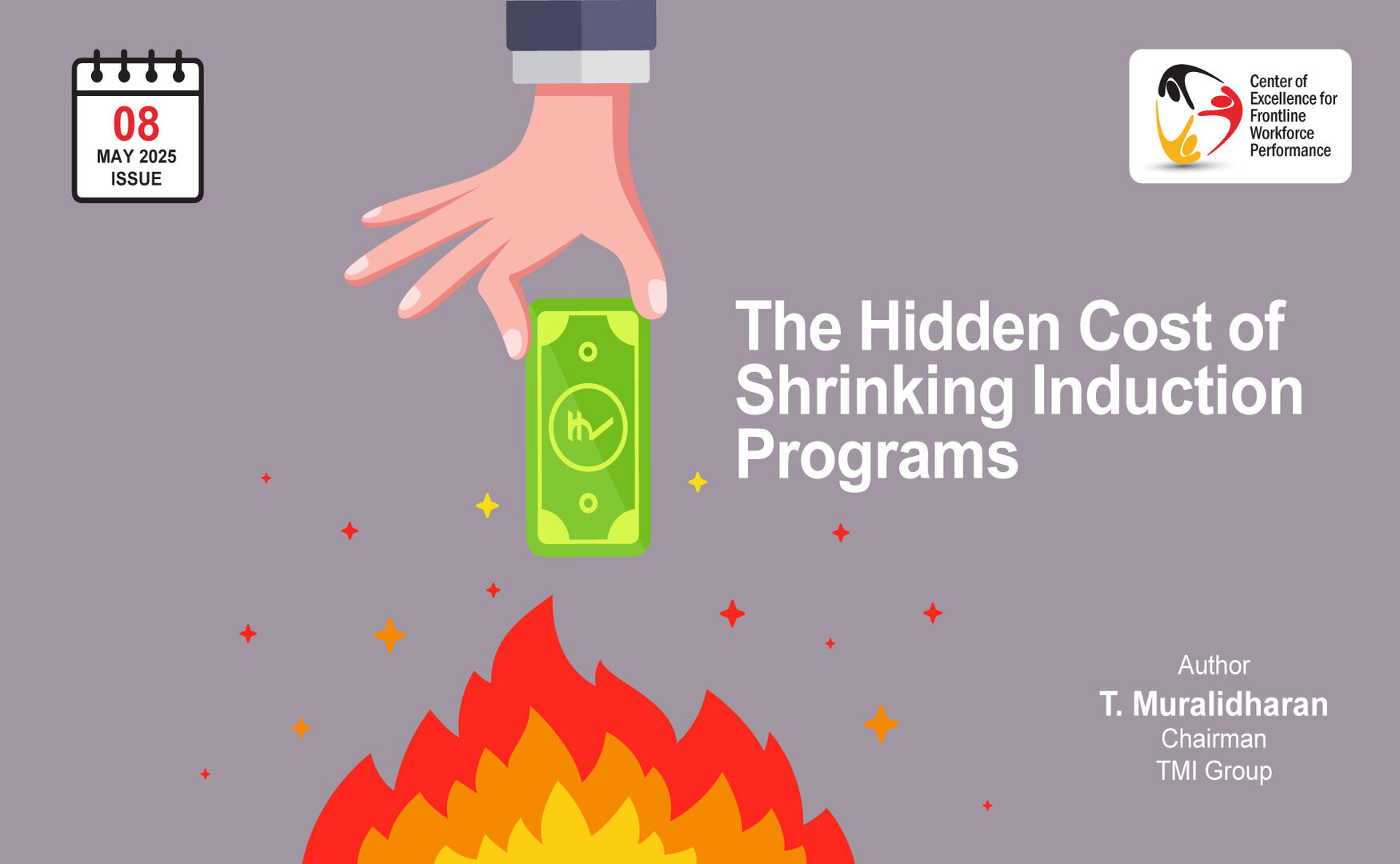
The Hidden Cost of Shrinking Induction Programs
Across frontline industries, a troubling trend is gaining ground: companies are dramatically reducing induction training durations, often in a bid to save time or costs. But this short-term optimization may be creating long-term damage.
A few years ago, large organizations — particularly in sectors like banking and financial services — ran induction programs lasting 21 days or more. Today, that number has dwindled to 7 days, sometimes less.
This shift isn’t just operational. It’s strategic. And it’s costing businesses in ways that aren’t always visible on a balance sheet — yet are deeply felt in productivity, engagement, and attrition.
A Mismatch Between Preparation and Performance
Today’s frontline talent is predominantly Gen Z — graduates from Tier 2 and Tier 3 colleges, often entering the workforce for the first time. Many have been part of education systems where they were treated more like customers than contributors. They arrive in the workplace with potential, but limited exposure to professional expectations.
Placing these individuals into week-long induction programs and expecting them to perform from Day 8 is a systemic mismatch. The result? High failure rates, low morale, delayed productivity, and early exits.
This is not a generational challenge — it’s a training design flaw.
Why Traditional Induction Isn’t Working
Short induction programs tend to be content-heavy and context-light. They often compress product knowledge, compliance, sales processes, customer behavior, and competitive landscape into marathon classroom sessions.
Yet, absorption is minimal. Studies indicate that 84% of sales training content is forgotten within the first three months (source). Even more concerning: in many organizations, the induction becomes a compliance checklist — not a capability-building journey.
How to Evaluate an Effective Induction Program
At the Center of Excellence for the Frontline Workforce, established by TMI and Quanta People, we’ve identified three core metrics that offer actionable insights into whether an induction program is actually working:
1. Time to First Sale
The first sale is more than a business metric — it’s a psychological breakthrough. It signals that the employee understands the product, the customer, and their own ability to win. In roles like home loan sales, the average time to first sale is 2.6–2.8 months. An effective induction program should shorten this window, creating momentum and early success.
Notably, sales reps who undergo comprehensive onboarding programs become productive 3.4 months sooner than those with less effective onboarding.
The first sale is more than a business metric — it’s a psychological breakthrough. It signals that the employee understands the product, the customer, and their own ability to win. In roles like home loan sales, the average time to first sale is 2.6–2.8 months. An effective induction program should shorten this window, creating momentum and early success.
Notably, sales reps who undergo comprehensive onboarding programs become productive 3.4 months sooner than those with less effective onboarding.
2. Role Mastery Index
Understanding the job isn’t enough. Mastery means being able to navigate real-world scenarios with confidence and competence.
To measure this, we’re developing a tech-enabled platform called MIRROR — a role simulation tool that allows employees to self-assess against defined job scenarios. It tracks how quickly individuals progress from awareness to application and issues certification based on actual role readiness — not just attendance or theory.
Understanding the job isn’t enough. Mastery means being able to navigate real-world scenarios with confidence and competence.
To measure this, we’re developing a tech-enabled platform called MIRROR — a role simulation tool that allows employees to self-assess against defined job scenarios. It tracks how quickly individuals progress from awareness to application and issues certification based on actual role readiness — not just attendance or theory.
3. Infant Attrition Rate
High attrition in the first 3–6 months is a red flag. It often signals that new hires feel unsupported or misaligned with their roles. When induction is effective, employees know what success looks like — and how to achieve it. As role clarity increases, early attrition drops.
This is one of the clearest ROI indicators for any induction investment. Alarmingly, up to 20% of employee turnover occurs within the first 45 days, emphasizing the critical nature of effective onboarding.
High attrition in the first 3–6 months is a red flag. It often signals that new hires feel unsupported or misaligned with their roles. When induction is effective, employees know what success looks like — and how to achieve it. As role clarity increases, early attrition drops.
This is one of the clearest ROI indicators for any induction investment. Alarmingly, up to 20% of employee turnover occurs within the first 45 days, emphasizing the critical nature of effective onboarding.
The Real Cost of Cutting Corners
Some companies fall into a reactive cycle: “They’ll leave anyway, so let’s reduce training time.” But this mindset becomes a self-fulfilling prophecy. Poor training leads to poor performance, which leads to attrition — and more reluctance to invest in future hires.
This isn’t just a talent problem. It’s a business risk.
When new hires leave early, companies lose time, money, and momentum. Worse, employees leave with diminished confidence and brand disillusionment. Over time, this erodes both employer brand equity and frontline effectiveness.
Moreover, the organizational costs of employee turnover are estimated to range between 100% and 300% of the replaced employee’s salary, highlighting the financial implications of inadequate onboarding.
The Path Forward
Induction isn’t a formality — it’s a performance strategy.
When designed well, it accelerates capability, boosts confidence, and directly impacts revenue and retention. For CHROs and CEOs, the call to action is clear: treat induction as the first lever of productivity, not an afterthought.
Measure what matters. Optimize for role success. And build programs that don’t just welcome employees — but enable them to win.


